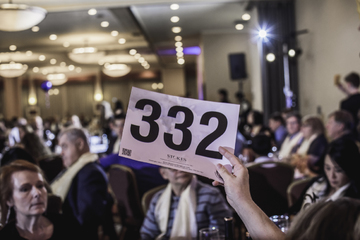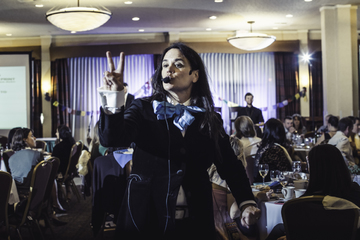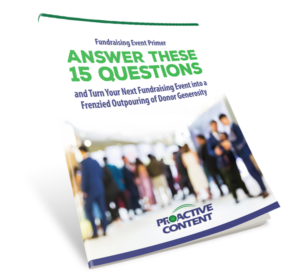7 Stratospheric Live Auction Tips That Will Make Your Next Event Break All Your Previous Records
Grow Your Fundraising Auction Revenue without Increasing Your Costs
 Your live fundraising auction is one of your primary revenue generators. The whole event brings in a lot of money, but it’s the live auction that’s usually the biggest draw.
Your live fundraising auction is one of your primary revenue generators. The whole event brings in a lot of money, but it’s the live auction that’s usually the biggest draw.
Hopefully, you’ve got a professional auctioneer. That’s step 0 – don’t bother doing a live auction without one. But that’s just the beginning. To make the most out of your event, you need to think through specific details like the ones you’re about to read and make decisions that will maximize revenue.
If this is your first live auction, pay close attention. If you’ve done them before but want to increase your profits, look below for the one or two ideas you haven’t tried before.
Here are 7 live auction tips and strategies for boosting fundraising event revenue with very little expense.
1. Look for Experiences, Not Items
Even expensive items like TVs and iPhones aren’t usually ideal for live auctions. We all know what these are worth, so it’s tough to get people to spend big on them. These kinds of items work better as raffle prizes.
But experiences have much higher perceived value, even ones that you could do for less money.
There are 3 levels of fundraising auction experiences. Exciting. Memorable. And Life-Changing.
Exciting Experiences
The higher perceived value of Exciting Experiences is why travel packages, weekend getaways, nights on the town (hotels, entertainment + restaurants), wine tastings and sports packages sell so well.
You’re buying a pre-packaged experience, and the planning has already been done. It’s a vacation in a box.
Memorable Experiences
Memorable Experiences are more unique than Exciting ones. These are things most people wouldn’t normally think of as something to do, but that have instant appeal when they hear about it.
Things like a behind-the-scenes experience for kids at the fire station. Be mayor for a day. The Genesis Project once offered a behind-the-scenes experience at a TV news station through a connection they have.
Race car driving, hot air balloons, cook-with-the-chef, airplane and helicopter rides – these kinds of things are so unique and special, and offer a chance to do something with loved ones that they’ll remember for years.
Way better than an iPhone.
Life-Changing Experiences
Life-Changing Experiences are ones only your nonprofit can offer. Sometimes these can be items as well, because the items have instant emotional meaning for the buyer.
Bikeworks auctions off real bikes that are rebuilt by the teenagers in their program. Union Gospel Mission in Seattle auctioned off wood furniture built by men going through their recovery and job skills program.
These things are priceless in the minds of your donors, because every time they look at the item, they instantly connect with the impact their support has had on people’s lives.
If you’re an animal shelter, auction off a ride-along rescuing an abused animal. A homeless shelter – go with the team as they count homeless people on the street.
Experiences have infinitely more value than items.
2. Double (or Triple) an Item
 This works with items and with experiences, as long as the donor is okay giving away more than one. If it’s a packaged experience such as the ones Winspire offers, you can sell as many as you want.
This works with items and with experiences, as long as the donor is okay giving away more than one. If it’s a packaged experience such as the ones Winspire offers, you can sell as many as you want.
An auctioneer knows how to do this. If two people are bidding each other up higher and higher, then once one of them wins, offer the trip to both of them for the LOSER’S price, not the winner’s.
This way, the winner feels like they got a deal, but you just sold two trips instead of one. If there are three bidders in the war, you can take the third highest offer and sell to all three.
3. Turn Losers Into Winners After Live Auction
With only a few items for sale, there will always be some people who wanted to buy something but walk away with nothing because they got outbid.
If you can spare a volunteer or staff person for this, have them write down the auction numbers of people who get outbid and win nothing. Then, follow up with those people via email after the event.
If there’s an experience, item, or event you can resell again, offer it to them for a lower price than the bidders paid, but one that still makes you a nice profit.
This way, the losers will become winners, and you’ll make more money.
4. Sequence Your Live Items
 A lot more could be written on this, but here’s a quick overview. Find your most desirable and biggest selling item, and put that one in the middle of your live auction. Maybe a bit past the middle. Then, build everything else around that, kind of like a bell curve.
A lot more could be written on this, but here’s a quick overview. Find your most desirable and biggest selling item, and put that one in the middle of your live auction. Maybe a bit past the middle. Then, build everything else around that, kind of like a bell curve.
Separate similar items so people who miss the first one still feel like there’s something for them to shoot for.
Put the least valuable items at the end. But not the least desirable items. Save something that a lot of people will want, but that isn’t as costly, for the last item. That way everyone stays for the whole auction.
Here’s an article from Winspire with much more detail about sequencing live auction items.
5. Create a Beautiful Live Auction Item Display
There’s a reason movie studios invest so much in creating exciting previews. It’s the same reason commercials for restaurants show the food in ultra-close-up, well-lit settings.
The reason: Maximize desire and curiosity.
You need to do the same thing with your live auction items. Create a beautiful display table your attendees can walk up to during the silent auction and while they’re finding their seats.
If you’re doing a Pick of the Live (Golden Ticket) game, have someone selling tickets nearby so they can point out the items the person might win.
6. Be Careful Where You Put Sponsored Tables
In general, people who come to live fundraising auctions as guests of table sponsors will give less than people who paid to come on their own. Guests are not usually core supporters, and often are hearing about your charity for the first time.
Anyone who comes by invitation from someone else, and who doesn’t pay for their ticket, is likely to give less money.
Because auctioneers will generally have a preferred zone of the room where they will want to fixate more of their attention. Tables farther away are harder for them to interact with.
You want the biggest donors to be closer to the auctioneer. So avoid putting sponsored tables in the prime real estate. Low-probability guests don’t belong in the auctioneer’s hot spot.
Where this is depends entirely on the layout of the room, so ask your auctioneer where she wants less-invested attendees like sponsored tables to be placed.
7. Always, Always, Always Do a Fund-a-Need
Like sequencing, there’s a lot more to be said about this. But here’s the main point: If you’re auctioning off 15 live items, and there are 150, 250, or 350 people in the room, that means less than 10% of your guests will walk away with a live auction item.
The great majority of people will buy nothing in the live auction. So if you don’t do a Fund-a-Need (also known as Raise the Paddle), you are leaving tens of thousands of dollars in the room.
This part of the live auction provides a way for everyone to give, even if they don’t win any live items.
Live Auction Tips – Inject Them into Your Planning
It takes a lot of time to plan a successful fundraising auction. Each of the tips you’ve just seen requires advanced planning. There’s not much extra cost to doing most of these. Probably spending something on a nice display is the biggest one.
But these do take time to implement. So make them part of your planning, months in advance. Make these your routine, and continue building on them year after year.
Need help planning?
Get a 15-step Fundraising Event Planning Guide, and use it to guide your auction planning from Day 1.



